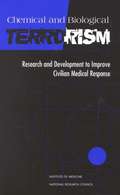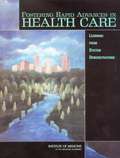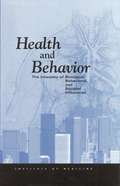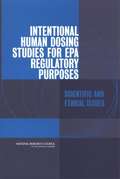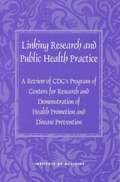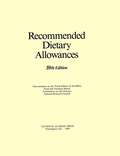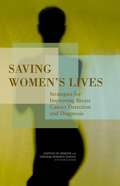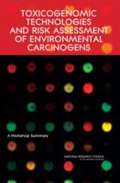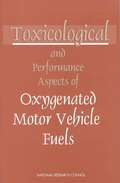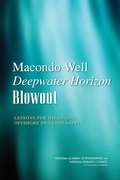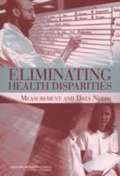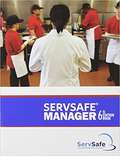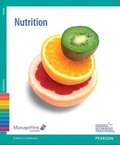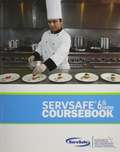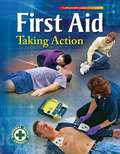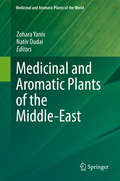- Table View
- List View
Chemical and Biological Terrorism: Research and Development to Improve Civilian Medical Response
by National Research CouncilThe threat of domestic terrorism today looms larger than ever. Bombings at the World Trade Center and Oklahoma City's Federal Building, as well as nerve gas attacks in Japan, have made it tragically obvious that American civilians must be ready for terrorist attacks. What do we need to know to help emergency and medical personnel prepare for these attacks? Chemical and Biological Terrorism identifies the R&D efforts needed to implement recommendations in key areas: pre-incident intelligence, detection and identification of chemical and biological agents, protective clothing and equipment, early recognition that a population has been covertly exposed to a pathogen, mass casualty decontamination and triage, use of vaccines and pharmaceuticals, and the psychological effects of terror. Specific objectives for computer software development are also identified. The book addresses the differences between a biological and chemical attack, the distinct challenges to the military and civilian medical communities, and other broader issues. This book will be of critical interest to anyone involved in civilian preparedness for terrorist attack: planners, administrators, responders, medical professionals, public health and emergency personnel, and technology designers and engineers.
Fostering Rapid Advances in Health Care: Learning from System Demonstrations
by National Research CouncilIn response to a request from the Secretary of the Department of Health and Human Services, the Institute of Medicine convened a committee to identify possible demonstration projects that might be implemented in 2003, with the hope of yielding models for broader health system reform within a few years. The committee is recommending a substantial portfolio of demonstration projects, including chronic care and primary care demonstrations, information and communications technology infrastructure demonstrations, health insurance coverage demonstrations, and liability demonstrations. As a set, the demonstrations address key aspects of the health care delivery system and the financing and legal environment in which health care is provided.
Health and Behavior: The Interplay of Biological, Behavioral, and Societal Influences
by National Research CouncilHealth and Behavior reviews our improved understanding of the complex interplay among biological, psychological, and social influences and explores findings suggested by recent research-including interventions at multiple levels that we can employ to improve human health. The book covers three main areas: What do biological, behavioral, and social sciences contribute to our understanding of health-including cardiovascular, immune system and brain functioning, behaviors that influence health, the role of social networks and socioeconomic status, and more. What can we learn from applied research on interventions to improve the health of individuals, families, communities, organizations, and larger populations? How can we expeditiously translate research findings into application?
Intentional Human Dosing Studies For EPA Regulatory Purposes: Scientific And Ethical Issues
by National Research CouncilThe EPA commissioned The National Academies to provide advice on the vexing question of whether and, if so, under what circumstances EPA should accept and consider intentional human dosing studies conducted by companies or other sources outside the agency (so-called third parties) to gather evidence relating to the risks of a chemical or the conditions under which exposure to it could be judged safe. This report recommends that such studies be conducted and used for regulatory purposes only if all of several strict conditions are met, including the following: The study is necessary and scientifically valid, meaning that it addresses an important regulatory question that can’t be answered with animal studies or nondosing human studies;The societal benefits of the study outweigh any anticipated risks to participants. At no time, even when benefits beyond improved regulation exist, can a human dosing study be justified that is anticipated to cause lasting harm to study participants; andAll recognized ethical standards and procedures for protecting the interests of study participants are observed.In addition, EPA should establish a Human Studies Review Board (HSRB) to evaluate all human dosing studies – both at the beginning and upon completion of the experiments – if they are carried out with the intent of affecting the agency's policy-making.
Linking Research and Public Health Practice: A Review of CDC's Program of Centers for Research and Demonstration of Health Promotion and Disease Prevention
by National Research CouncilHealth promotion and disease prevention are central priorities in the Centers for Disease Control and Prevention (CDC) vision. To advance research in these areas, Congress authorized and CDC established a program of university-based Centers for Research and Demonstration of Health Promotion and Disease Prevention to explore improved ways of appraising health hazards and to serve as demonstration sites for new and innovative research in public health. Begun in 1986 with three centers, there are now fourteen. In response to a CDC request to evaluate the program, Linking Research and Public Health Practice examines the vision for the prevention research centers program, the projects conducted by the centers, and the management and oversight of the program. In conducting the evaluation, the IOM committee took a broad view of how prevention research can influence the health of communities, and considered both the proximal risk factors for disease prevention and the more distal conditions for health promotion and improved equity in the distribution of risk factors. Month?
Readiness Issues Related to Research in the Biological and Physical Sciences on the International Space Station
by National Research CouncilThe National Academies Press (NAP)--publisher for the National Academies--publishes more than 200 books a year offering the most authoritative views, definitive information, and groundbreaking recommendations on a wide range of topics in science, engineering, and health. Our books are unique in that they are authored by the nation's leading experts in every scientific field.
Recommended Dietary Allowances (10th edition)
by Subcommittee on the Tenth Edition of the RDAs National Research CouncilSince its introduction in 1943, "Recommended Dietary Allowances" has become the accepted source of nutrient allowances for healthy people. These Recommended Dietary Allowances (RDAs) are used throughout the food and health fields. Additionally, RDAs serve as the basis for the U.S. Recommended Daily Allowances, the Food and Drug Administration's standards for nutrition labeling of foods. The "10th Edition" includes research results and expert interpretations from years of progress in nutrition research since the previous edition and provides not only RDAs but also "Estimated Safe and Adequate Daily Dietary Intakes" - provisional values for nutrients where data were insufficient to set an RDA. Organized by nutrient for ready reference, the volume reviews the function of each nutrient in the human body, sources of supply, effects of deficiencies and excessive intakes, relevant study results, and more. The volume concludes with the invaluable "Summary Table of Recommended Dietary Allowances," a convenient and practical summary of the recommendations.
Saving Women's Lives: Strategies for Improving Breast Cancer Detection and Diagnosis
by National Research CouncilThe outlook for women with breast cancer has improved in recent years. Due to the combination of improved treatments and the benefits of mammography screening, breast cancer mortality has decreased steadily since 1989. Yet breast cancer remains a major problem, second only to lung cancer as a leading cause of death from cancer for women. To date, no means to prevent breast cancer has been discovered and experience has shown that treatments are most effective when a cancer is detected early, before it has spread to other tissues. These two facts suggest that the most effective way to continue reducing the death toll from breast cancer is improved early detection and diagnosis. Building on the 2001 report Mammography and Beyond, this new book not only examines ways to improve implementation and use of new and current breast cancer detection technologies but also evaluates the need to develop tools that identify women who would benefit most from early detection screening. Saving Women’s Lives: Strategies for Improving Breast Cancer Detection and Diagnosis encourages more research that integrates the development, validation, and analysis of the types of technologies in clinical practice that promote improved risk identification techniques. In this way, methods and technologies that improve detection and diagnosis can be more effectively developed and implemented.
The Swine Flu Affair: Decision-Making on a Slippery Disease
by National Research CouncilIn 1976, a small group of soldiers at Fort Dix were infected with a swine flu virus that was deemed similar to the virus responsible for the great 1918-19 world-wide flu pandemic. The U.S. government initiated an unprecedented effort to immunize every American against the disease. While a qualified success in terms of numbers reached-more than 40 million Americans received the vaccine-the disease never reappeared. The program was marked by controversy, delay, administrative troubles, legal complications, unforeseen side effects and a progressive loss of credibility for public health authorities. In the waning days of the flu season, the incoming Secretary of what was then the Department of Health, Education and Welfare, Joseph Califano, asked Richard Neustadt and Harvey Fineberg to examine what happened and to extract lessons to help cope with similar situations in the future. The result was their report, The Swine Flu Affair: Decision-Making on a Slippery Disease
Toxicogenomic Technologies and Risk Assessment of Environmental Carcinogens: A Workshop Summary
by National Research CouncilToxicogenomics is a discipline that combines expertise in toxicology, genetics, molecular biology, and environmental health to help understand the response of living organisms to stressful environments. The National Research Council convened a workshop to discuss how toxicogenomic data could be applied to improve risk assessments, particularly cancer risk from environmental exposure to chemicals. Risk assessments serve as the basis of many public-health decisions in environmental, occupational, and consumer protection from chemicals. The workshop provided a forum for communities of experts, including those working in "-omics" and those in the policy arena, to discuss where their fields intersect, and how toxicogenomics could address critical knowledge gaps in risk assessments.
Toxicological and Performance Aspects of Oxygenated Motor Vehicle Fuels
by National Research CouncilThis book reviews a draft report from the federal government that assesses the effects of oxygenated gasoline on public health, air quality, fuel economy, engine performance, and water quality. In addition to evaluating the scientific basis of the report, the book identifies research needed to better understand the impacts of oxygenated fuels. Methyl tertiary-butyl ether (MTBE), which is intended to reduce carbon monoxide pollution during winter, is the most commonly used additive in the federal oxygenated fuels program. MTBE has been implicated in complaints by the public of headaches, coughs, and nausea. Other questions have been raised about reduced fuel economy and engine performance and pollution of ground water due to the use of MTBE in gasoline. The book provides conclusions and recommendations about each major topic addressed in the government's report.
Macondo Well Deepwater Horizon Blowout
by National Research Council (U.S.), Committee on the Analysis of Causes of the Deepwater Horizon Explosion, Fire, and Oil Spill to Identify Measures to Prevent Similar Accidents in the Future Staff National Research Council (U.S.), Board on Environmental Studies and Toxicology Staff"The blowout of the Macondo well on April 20, 2010, led to enormous consequences for the individuals involved in the drilling operations, and for their families. Eleven workers on the Deepwater Horizon drilling rig lost their lives and 16 others were seriously injured. There were also enormous consequences for the companies involved in the drilling operations, to the Gulf of Mexico environment, and to the economy of the region and beyond. The flow continued for nearly 3 months before the well could be completely killed, during which time, nearly 5 million barrels of oil spilled into the gulf. Macondo Well-Deepwater Horizon Blowout examines the causes of the blowout and provides a series of recommendations, for both the oil and gas industry and government regulators, intended to reduce the likelihood and impact of any future losses of well control during offshore drilling. According to this report, companies involved in offshore drilling should take a "system safety" approach to anticipating and managing possible dangers at every level of operation -- from ensuring the integrity of wells to designing blowout preventers that function under all foreseeable conditions-- in order to reduce the risk of another accident as catastrophic as the Deepwater Horizon explosion and oil spill. In addition, an enhanced regulatory approach should combine strong industry safety goals with mandatory oversight at critical points during drilling operations. Macondo Well-Deepwater Horizon Blowout discusses ultimate responsibility and accountability for well integrity and safety of offshore equipment, formal system safety education and training of personnel engaged in offshore drilling, and guidelines that should be established so that well designs incorporate protection against the various credible risks associated with the drilling and abandonment process. This book will be of interest to professionals in the oil and gas industry, government decision makers, environmental advocacy groups, and others who seek an understanding of the processes involved in order to ensure safety in undertakings of this nature. "--Publisher's description.
Continuing Assistance to the National Institutes of Health on Preparation of Additional Risk Assessments for the Boston University NEIDL, Phase 1
by National Research Council of the National AcademiesIn 2003, the Boston University Medical Center (BUMC) was awarded a $128 million grant from the National Institutes of Health to build one of two high- and maximum- containment laboratory facilities for research on biological pathogens. The National Emerging Infectious Disease Laboratories (NEIDL) are meant to support the National Institute of Allergy and Infectious Diseases and biodefense research agenda, conducting research to develop new approaches to treating, preventing, and diagnosing a variety of viral diseases. Diseases and agents to be studied include viruses and bacteria that occur naturally and cause infections or that could be used in deliberate attacks. Continuing Assistance to the National Institutes of Health on Preparation of Additional Risk Assessments for the Boston University NEIDL, Phase 1 reviews the proposed risk assessment plans associated with operating the NEIDL and provides input on key milestones in the development of supplementary risk assessment.
Eliminating Health Disparities: Measurement And Data Needs
by National Research Council of the National AcademiesDisparities in health and health care across racial, ethnic, and socioeconomic backgrounds in the United States are well documented. The reasons for these disparities are, however, not well understood. Current data available on race, ethnicity, SEP, and accumulation and language use are severely limited. The report examines data collection and reporting systems relating to the collection of data on race, ethnicity, and socioeconomic position and offers recommendations.
Recognition and Alleviation of Pain in Laboratory Animals
by National Research Council of the National AcademiesThe use of animals in research adheres to scientific and ethical principles that promote humane care and practice. Scientific advances in our understanding of animal physiology and behavior often require theories to be revised and standards of practice to be updated to improve laboratory animal welfare. Recognition and Alleviation of Pain in Laboratory Animals, the second of two reports revising the 1992 publication Recognition and Alleviation of Pain and Distress in Laboratory Animals from the Institute for Laboratory Animal Research (ILAR), focuses on pain experienced by animals used in research. This book aims to educate laboratory animal veterinarians; students, researchers and investigators; Institutional Animal Care and Use Committee members; and animal care staff and animal welfare officers on the current scientific and ethical issues associated with pain in laboratory animals. It evaluates pertinent scientific literature to generate practical and pragmatic guidelines for recognizing and alleviating pain in laboratory animals, focusing specifically on the following areas: physiology of pain in commonly used laboratory species; pharmacologic and non-pharmacologic principles to control pain; identification of humane endpoints; and principles for minimizing pain associated with experimental procedures. Finally, the report identifies areas in which further scientific investigation is needed to improve laboratory animal welfare.
ServSafe Alcohol: Fundamentals of Responsible Alcohol Service, Second Edition
by National Restaurant AssociationServSafe Alcohol is vital, practical and current responsible alcohol service training. It implements the same approach ServSafe® pioneered for the industry's most recognized food safety training and certification. ServSafe Alcohol includes the latest studies and science-based information, explores real-world situations and makes it all engaging and accessible with the latest instructional design techniques. That makes ServSafe Alcohol a smart training solution for every operation and every classroom. The ServSafe Alcohol program was developed with input from experts in the restaurant, legal, regulatory, academic, insurance, medical and law enforcement fields. Together, they determined the tasks that the front-of-the-house needs to know.
ServSafe CourseBook 7th Edition
by National Restaurant Association<P>Congratulations! By opening this book, you are joining millions of foodservice professionals in taking the first step in a commitment to food safety.<P> ServSafe® training helps you understand all of the food safety risks faced by your operation. <P>Once you're aware of these risks, you can find ways to reduce them.
ServSafe Manager (6th Edition)
by National Restaurant AssociationThis book prepares you to complete the Food Safety Food Manager certification.
Servsafe Manager (7th Edition)
by National Restaurant AssociationThis is the most current edition of the ServSafe Manager Textbook and will help prepare you for the ServSafe Food Protection Manager Exam.
Nutrition
by National Restaurant Association StaffThis text focuses on NUTRITION topics. It includes essential content plus learning activities, case studies, professional profiles, research topics and more that support course objectives. The text and exam are part of the ManageFirst Program® from the National Restaurant Association (NRA). This edition is created to teach restaurant and hospitality students the core competencies of the Ten Pillars of Restaurant Management. The Ten Pillars of Restaurant Management is a job task analysis created with the input and validation of the industry that clearly indicates what a restaurant management professional must know in order to effectively and efficiently run a safe and profitable operation. The ManageFirst Program training program is based on a set of competencies defined by the restaurant, hospitality and foodservice industry as those needed for success. This competency-based program features 10 topics each with a textbook, online exam prep for students, instructor resources, a certification exam, certificate, and credential. The online exam prep for students is available with each textbook and includes helpful learning modules on test-taking strategies, practice tests for every chapter, a comprehensive cumulative practice test, and more! This textbook includes an exam answer sheet to be used with the paper-and-pencil version of the ManageFirst certification exam.
Servsafe Coursebook (Sixth Edition)
by National Restaurant Association StaffLearn everything you need to know about safe food handling, how to train your employees, what to watch for to make sure you and the people around you stay healthy, how to keep a safe and sanitary work environment.
NSC Bloodborne and Airborne Pathogens Workbook
by National Safety Council StaffPART OF National Safety Council to save lives through education, research and advocacy.
First Aid: Taking Action
by National Safety Council staff and affiliatesFirst Aid: Taking Action is a comprehensive and reader-friendly first aid textbook designed both for lay people and more highly trained healthcare personnel and professional rescuers. You will learn everything you need to know to provide basic life support and first aid in an emergency. First Aid: Taking Action is unique as a textbook in maintaining a dual focus throughout. The primary goal is to teach people what to do in different emergencies, and many of the text's features are designed to present this practical information concisely and visually in a manner that aids retention. At the same time, since people remember key information longer and can better apply it in real-life situations when they understand the underlying principles, the text also discusses what is happening within the body in emergencies and how and why first aid actions are effective.
Medicinal and Aromatic Plants of the Middle-East
by Nativ Dudai Zohara YanivThe current volume, "Medicinal and Aromatic Plants of the Middle-East" brings together chapters on selected, unique medicinal plants of this region, known to man since biblical times. Written by leading researchers and scientists, this volume covers both domesticated crops and wild plants with great potential for cultivation. Some of these plants are well-known medicinally, such as opium poppy and khat, while others such as apharsemon and citron have both ritual and medicinal uses. All have specific and valuable uses in modern society. As such, it is an important contribution to the growing field of medicinal and aromatic plants. This volume is intended to bring the latest research to the attention of the broad range of botanists, ethnopharmacists, biochemists, plant and animal physiologists and others who will benefit from the information gathered therein. Plants know no political boundaries, and bringing specific folklore to general medical awareness can only be for the benefit of all.
The Complete Vegan Cookbook: Over 150 Whole-Foods, Plant-Based Recipes and Techniques
by Natural GourmetFrom the leading health-focused culinary school comes a comprehensive natural foods bible that shares forty years' worth of tools and techniques for more than 150 health-supportive recipes.In its forty-year history, Natural Gourmet has trained many natural food chefs in the art of healthy cooking. Their curriculum emphasizes local ingredients and the philosophy of using food as medicine. Now, in their very first cookbook, Natural Gourmet reveals how to utilize whole seasonal ingredients in creative and delicious ways. You'll learn about methods for sourcing sustainable ingredients, principles of nutrition, and much more. Every recipe is perfect for anybody wanting to eat a little healthier, whether to adhere to a specific diet, to do better for the earth, or just to feel better.
